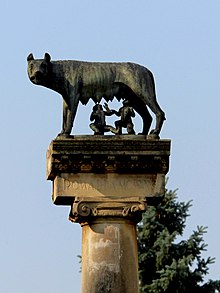 | |
|
| |
| 45°45′8″N 21°13′30″E / 45.75222°N 21.22500°E | |
| Location | Victory Square, Timișoara |
|---|---|
| Type | Statue |
| Material | Bronze |
| Height | 4.96 m |
| Opening date | 23 April 1926 |
| LMI code | TM-III-m-B-06314 |
Capitoline Wolf is a statue located in Timișoara's Victory Square, between the Metropolitan Cathedral and the Palace of Culture. Copy of the famous Capitoline Wolf, the statue was donated by the municipality of Rome in 1926 as a symbol of Latinity that unites the Romanian and Italian peoples. The statue depicts the legend of the founders of Rome, the brothers Romulus and Remus, suckled by a she-wolf. The statue is inscribed in the list of historical monuments with the code TM-III-m-B-06314. [1]
Description
Made of bronze, [2] the statue is a copy of the famous Capitoline Wolf, today on display in the Capitoline Museums in Rome, and is placed on a 4.96-meter-high socle imitating an ancient column. [3]
History
Between 1906 and 1926, the Italian state gave Romania four copies of the statue as a sign of recognition of the Latin origin of the Romanian people and the ties between the two peoples. The first statue was donated to Bucharest on the 1800th anniversary of the conquest of Dacia and the 25th anniversary of the reign of Carol I as king of Romania. The other three arrived in Cluj and Chișinău in 1921 and in Timișoara in 1926. It was the first monument unveiled in Timișoara after the creation of Greater Romania. [4]
The monument was unveiled on St. George's Day, 23 April 1926, in the presence of 10,000 people. The event was also attended by Samuil Șagovici, the then mayor of the city, Vasile Goldiș, the minister of Cults, Grigore Trancu-Iași, the minister of Labor, but also representatives of the National Fascist Party. [3] The handover was made by Giulio Cesare Codecà, appointed in 1922 consular agent of Italy in Timișoara, with jurisdiction throughout the Romanian Banat. [4] The solemnity took place with the total exclusion from any role of the former mayor of Timișoara, Lucian Georgevici, who was forced to resign on 17 April, in a tense climate. [5]
The statue was removed during World War II, after Romania turned its weapons against the Axis powers, with which it went to war. The Romanians from Timișoara decided to protest against Fascist Italy led by Mussolini, which supported Hungary to obtain Northern Transylvania. In Banat's speech, it was shouted then Duce, duce, ia-ți cățaua și ți-o fuce ("Duke, duke, take your bitch and fuck her"), alluding to Benito Mussolini's nickname, Il Duce. [5] During Nicolae Ceaușescu's time, local officials decided to put the statue back in its place in the center of Timișoara. [3]
References
- ^ Antoniuc, Doina; et al. (2010). Județul Timiș: monumente de for public (PDF). Timișoara: Graphite. p. 144. ISBN 978-973-88664-5-4.
- ^ Almăjan, Ion Marin; Antoniuc, Doina; Medinski, Andrei (2002). Timișoara: monumente de artă plastică (PDF). Timișoara: Cosmopolitan Art. p. 13.
- ^ a b c Both, Ștefan (4 December 2012). "Legătura dintre statuia Lupoaicei din Timișoara și dictatorul fascist Benito Mussolini". Adevărul.
- ^ a b Păun, Liana (1 March 2015). "Statui emblematice ale orașului (VI). Povestea „lupoaicei" dăruite de statul italian". pressalert.ro.
- ^ a b "Cadou de la Mussolini, chiar de Sfântul Gheorghe, statuia Lupoaicei numără 88 de ani de când veghează Piața Operei din Timișoara. Află-i povestea!". Opinia Timișoarei. 23 April 2014.
